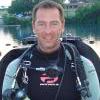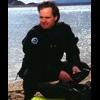Some of the first uses of surface supplied air were for rudimentary dives into the cavern zones of many submerged caves in the 1800's. The first cave dives conducted using SCUBA were made by Graham Balcombe of the British Cave Diving Group on November 22, 1936 in England at Swildon's Cave. While the modern demand regulator and equipment as we know it wouldn't be developed until the early 1940's by Jaques Cousteau and Emile Gagnan, less perfect SCUBA equipment was in use at the turn of the last century.
When the first of the Cousteau Aqua-Lungs arrived in the United States, they were almost immediately put into roles in cave diving exploration. While open water diving lacked any clubs, societies, or training at first, cave exploration already had many organizations involved in speleological research and adventure. Due to already existing structure, it was far easier to organize SCUBA training standards for cave diving. For example, the National Speleological Society was formed in 1941 and by 1947 was already publishing articles on cave diving. The Florida Speleological Society, a member of the National Speleological Society, developed the first cave diver training program in 1953 long before L.A. County, YMCA or any of the other open water training agencies were formed.
When we think of cave diving today, we often think of Florida, Mexico, and the Bahamas. But, during the 1950's SCUBA was being used to explore submerged caves in California, Nevada, New Jersey, New York, Pennsylvania, Georgia, Texas, Missouri and Virginia as well as Florida. These early cave dives were recording depths of 250 feet and penetrations of several hundred feet. Early divers enjoyed putting a pioneer spirit into action unlike the poor average brainwashed industry drone of today. What's an industry drone? Well, you probably are unless you can answer yes to the following questions:
1) Do you think 20 feet of visibility is awesome?
2) Have you ever just stopped your car and jumped into the water to see what was under a deserted stretch of beach or lake?
3) Have you ever found yourself in trouble with the Nat'l/State Park Service or the U.S. Navy?
4) Do you usually run into submerged wreckage without knowing it's there?
5) Do you read dive magazines & think, "This is all crap!" and wonder why you subscribe?
6) Do you plan most dives on the fly?
7) Is 500 psi still a lot of gas/time?
8) To you, Pink is a singer, Neon is a car, and plastic is something used to replace hips?
9) Are most dives kind of boring?
10) Have you ever found a strange 55 gallon drum?
If so, congratulations! You're a real diver with pioneer spirit and not an industry drone!
These early divers were able to enjoy diving without the trappings of the diving industry since it didn't exist
Throughout the 1960's cave diving grew in popularity. For example, at the start of the decade 1000 to 5000 divers were visiting Florida caves and by 1969 this number grew to 30,000 to 50,000 divers. Better depth gauges and measuring techniques led to a world record penetration of 1829 feet by John Harper and Randy Hylton in Madison Blue Springs, FL in 1969 and a 335 ffw mixed gas depth record by British diver Frank Salt in Zimbabwe's Sinola Caves in that same year. Tom Mount (president of IANTD) and Hal Watts (former deep air record holder) became major players in the cave game during this decade. Hal Watts was the first diver to add an additional second stage to a regulator forming the first "octopus" regulator. 1969 also saw the birth of the first official cave diving agency, the National Association for Cave Diving (NACD).
The 1970's found more divers visiting Florida caves than were visiting the reefs or the Florida Keys tallying over 156,000 per year. Why would so many more divers venture into caves than enjoy the abundant marine life and colors of coral reefs? Well, the caves are fresh water and "Jaws" was written by Peter Benchley and turned into a motion picture by Steven Spielberg during the 70's. So... no sharks in the caves, folks
Throughout the 1980's NSS-CDS trained divers enjoyed an unblemished safety record. Exley regained the cave depth record of 881 feet on trimix after Dale Sweet descended to 360 feet in Die Polder Sink I in FL and Jochen Hasenmayer went to 656 feet in France. By the close of the decade Bill Gavin (scooter fame), Bill Main, Lamar English and Parker Turner (George Irvine III's first cave instructor) made a record 8770 foot traverse in Wakulla.
Wakulla has been a major area of exploration since the FSU divers under the direction of Gary Salsman gained access to the area in the 1950's thanks to "The Creature of the Black Lagoon." The film crew's air compressor broke and Salsman happened to have one in a truck. They provided air and acted as support divers to gain access to the cave to which the property owner had denied them access. The Wakulla project spawned DIR diving under the leadership of George Irvine III and led to the creation of GUE after Irvine & Jarrod Jablonski set a world record in excess of 18,000 feet.
In the 1990's before his death Exley predicted that the future would find divers making 20,000 ffw pushes by the 2000's. A 21,000 ffw record dive in Brasil this year proved him correct. He also predicted that FL caves would experience deterioration of water quality, silting and water shortages due to the increasing population of FL. He was optimistic that cave divers would help find solutions to these problems.
How do we go from elementary school kids who believe in saving nature to selfish adults who want someone else to do it while we use up resources for future generations?













